The Best Places to Hang Wall Art Prints at Home
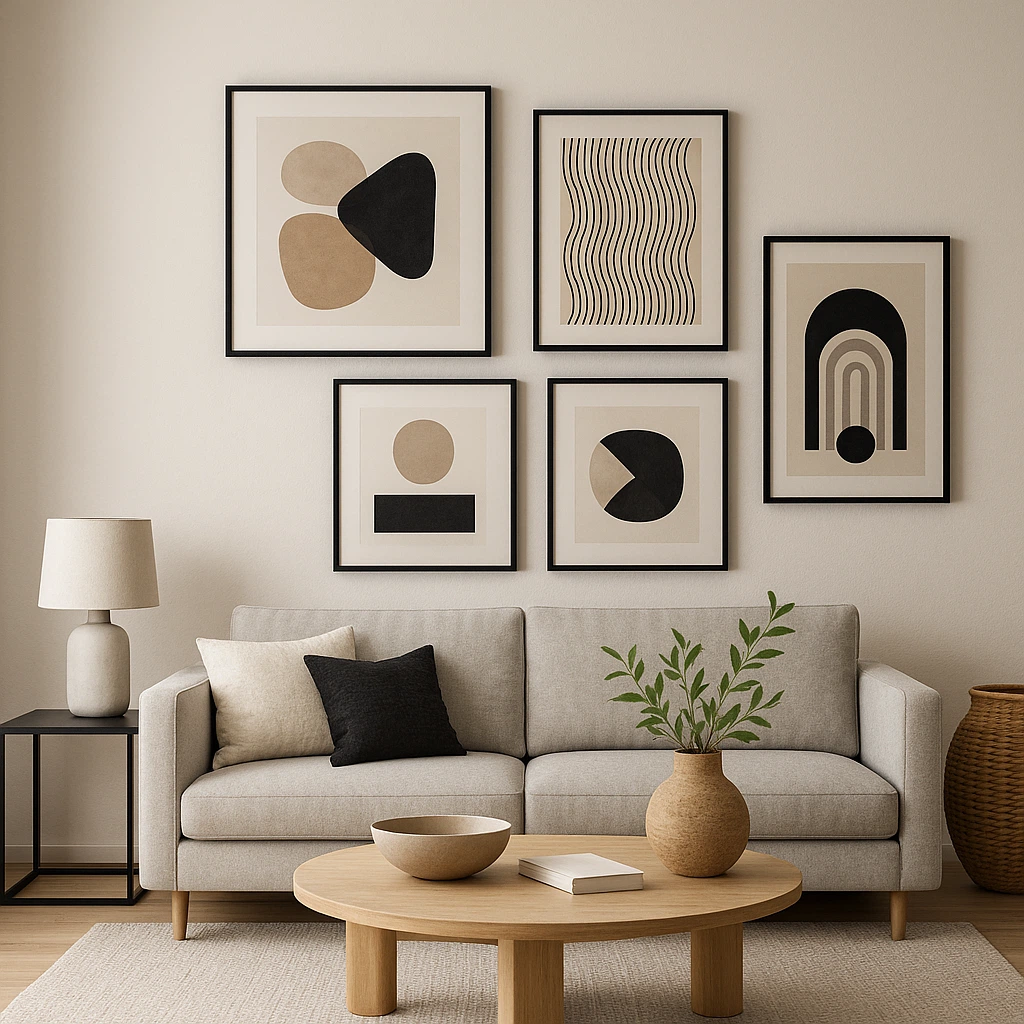
The Best Places to Hang Wall Art Prints at Home
Wall art prints are the personality pieces that transform blank walls into expressive statements about who you are and what you love. The strategic placement of these decorative elements can dramatically alter the feel of a room, creating focal points, adding depth, or establishing mood. While choosing beautiful art is important, knowing exactly where to position your prints is equally crucial for maximum impact. In this comprehensive guide, we’ll explore professional guidelines, creative ideas, and practical examples for hanging art in every room of your home, helping you create a space that feels both professionally designed and personally meaningful. You can find inspiration through retro wall art ideas that bring character and nostalgia to contemporary spaces.
Understanding art placement: height, scale, and sight lines
The impact of your wall art depends significantly on its placement. Even the most striking piece can lose its effect when hung too high, too low, or at an inappropriate scale for the wall. Most homeowners make common mistakes that diminish their art’s visual impact—hanging pieces at awkward heights, selecting prints too small for the intended wall, or failing to consider how the art will be viewed from different positions in the room.
Professional designers follow what’s known as the “museum standard”—hanging artwork so its center point sits approximately 57-60 inches from the floor, which corresponds to the average person’s eye level. This creates a comfortable viewing experience and brings consistency to your home’s overall design. When hanging art above furniture like sofas or consoles, maintain 4-8 inches of space between the furniture and the bottom of the frame to create visual breathing room while maintaining connection.
Scale and proportion play equally important roles in effective wall art placement. A general rule is to select art (or art groupings) that span roughly two-thirds the width of the furniture it hangs above. This creates balanced proportions that feel intentional rather than accidental. For walls without furniture, consider the entire wall as your canvas, allowing the architecture to guide appropriate sizing.
How to measure and mark for perfect placement
Achieving professional-looking art placement requires more than eyeballing. Follow these simple steps:
- Measure the height of your artwork and divide by two to find the midpoint
- Add 57-60 inches to determine where this midpoint should fall on your wall
- Mark this spot lightly with pencil
- Measure from the top of your frame to the hanging hardware
- Subtract this measurement from your midpoint mark to determine where hardware should be installed
For heavier pieces, consider investing in proper wall anchors and hanging hardware that can support the weight. Looking for striking prints with impact? Framed photo prints with bold geometric patterns make excellent statement pieces for prominent walls.
Best rooms and spaces to hang wall art prints
Every room in your home offers unique opportunities for displaying wall art. The best placement depends on the function of the space, typical viewing positions, and architectural features that might enhance or compete with your artwork. Let’s explore room by room to discover ideal art placement strategies.
Living room & above the sofa
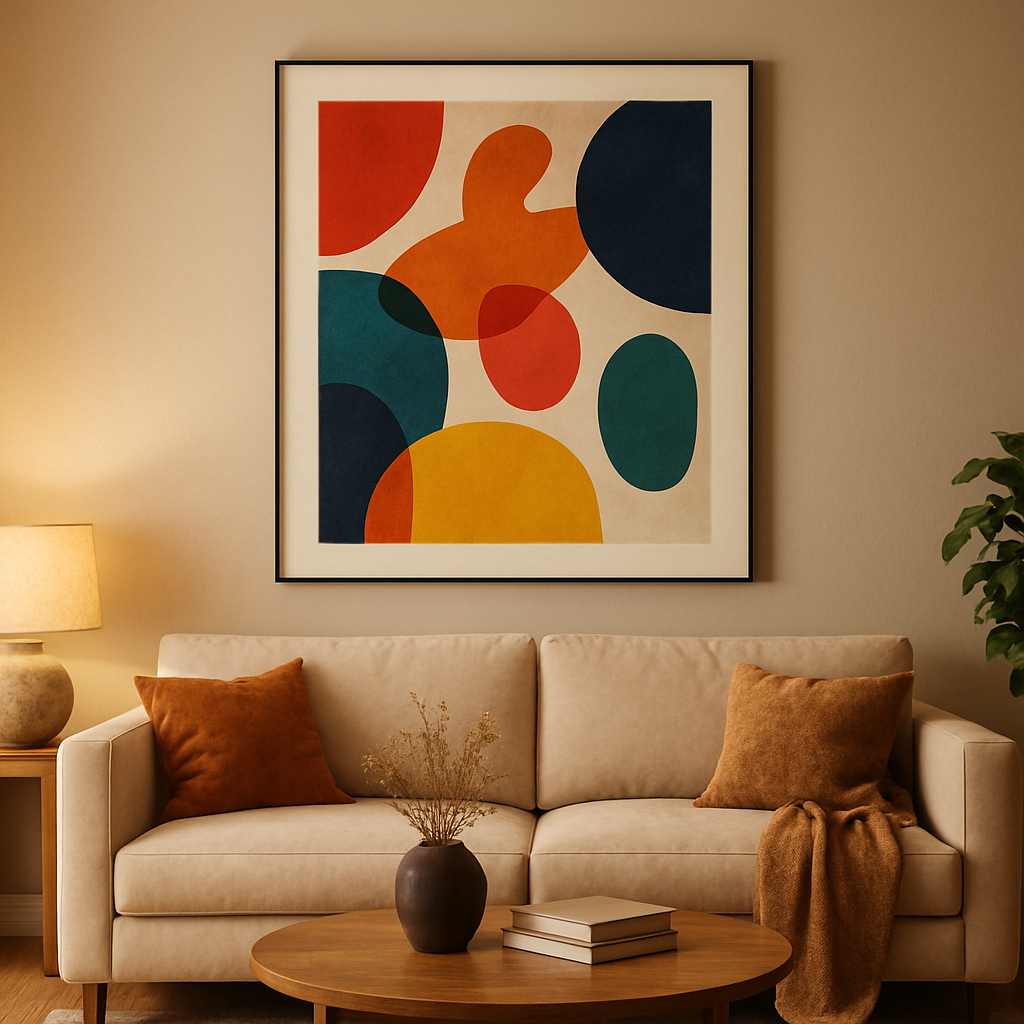
The perfect blend of art and comfort, enhancing the warmth of modern interior design.
The living room typically contains the most prominent wall space and sees the highest traffic, making it prime territory for your favorite art prints. The wall above the sofa is often the focal point, where a statement piece or thoughtfully arranged grouping can anchor the entire room.
When hanging art above a sofa, position the bottom edge 8-10 inches above the sofa back to create appropriate visual connection without risking damage from people leaning back.
Scale matters tremendously here—undersized art will look lost above a large sofa. Select a piece (or grouping) that spans approximately two-thirds the width of the sofa for balanced proportions. For sectionals or extra-long sofas, consider a triptych or series of coordinating prints that extend across the wall space, maintaining visual weight appropriate to the furniture below.
Opposite the seating area, consider what viewers will see when seated—this presents another opportunity for impactful wall art placement that can be enjoyed during conversations or while relaxing.
Bedroom and above the bed
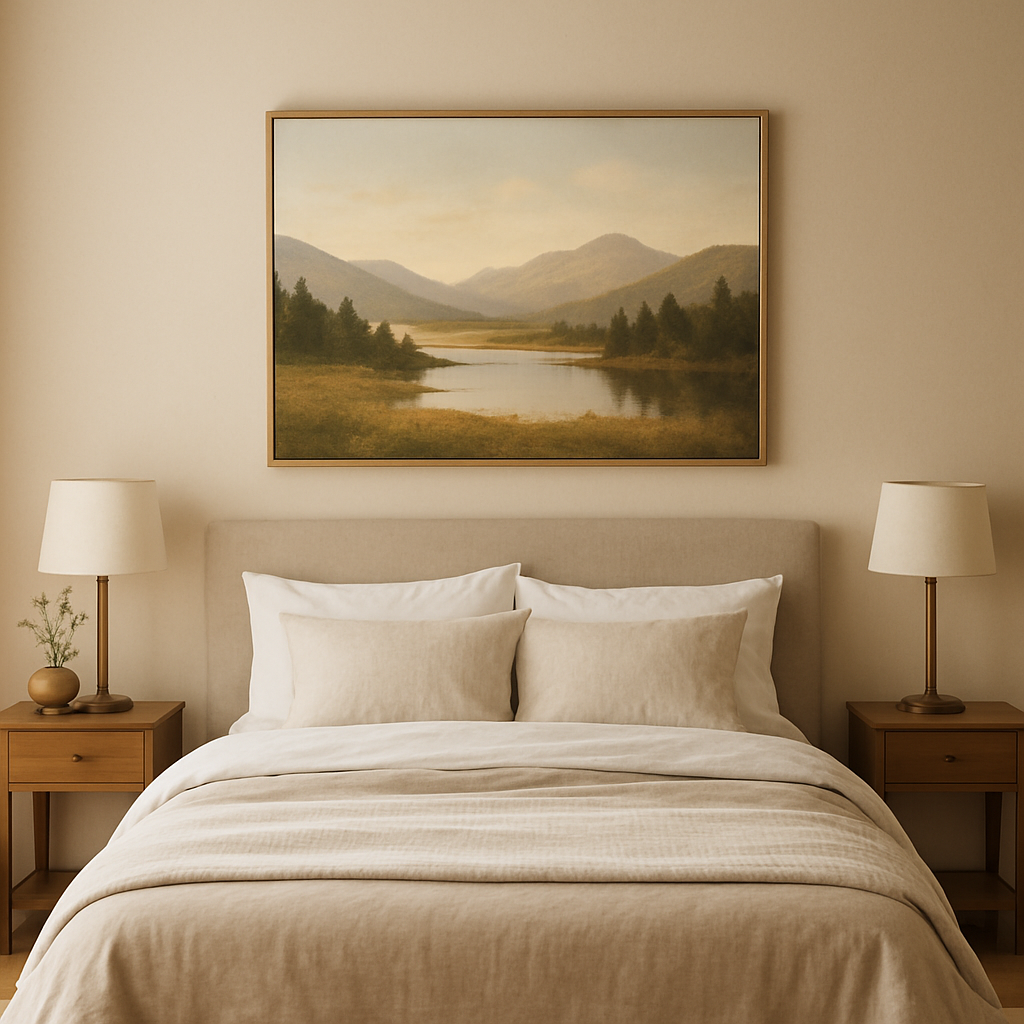
A serene bedroom setting where nature meets comfort.
The wall above your bed presents a natural focal point for bedroom wall art placement.
This prominent space sets the mood for the entire room, whether you prefer calming landscapes, abstract pieces, or personal photographs. When positioning art above the bed, the same principles apply regarding height and scale—center your art approximately 6-8 inches above the headboard, or at eye level if you have no headboard.
Consider the proportions of your bed when selecting artwork. For king and queen beds, larger pieces or groupings create appropriate balance, while twin or full beds may call for smaller, properly scaled art. If you have bedside lamps or sconces, ensure your art arrangement accommodates these elements without creating visual competition.
For a cohesive bedroom design, choose art that complements your bedding and overall color scheme—either by picking up accent colors or providing pleasing contrast to dominant tones in the room. Landscapes, botanical prints, or abstract pieces with soothing colors often work beautifully in bedrooms, supporting the restful atmosphere.
Dining room, kitchen & gathering spaces
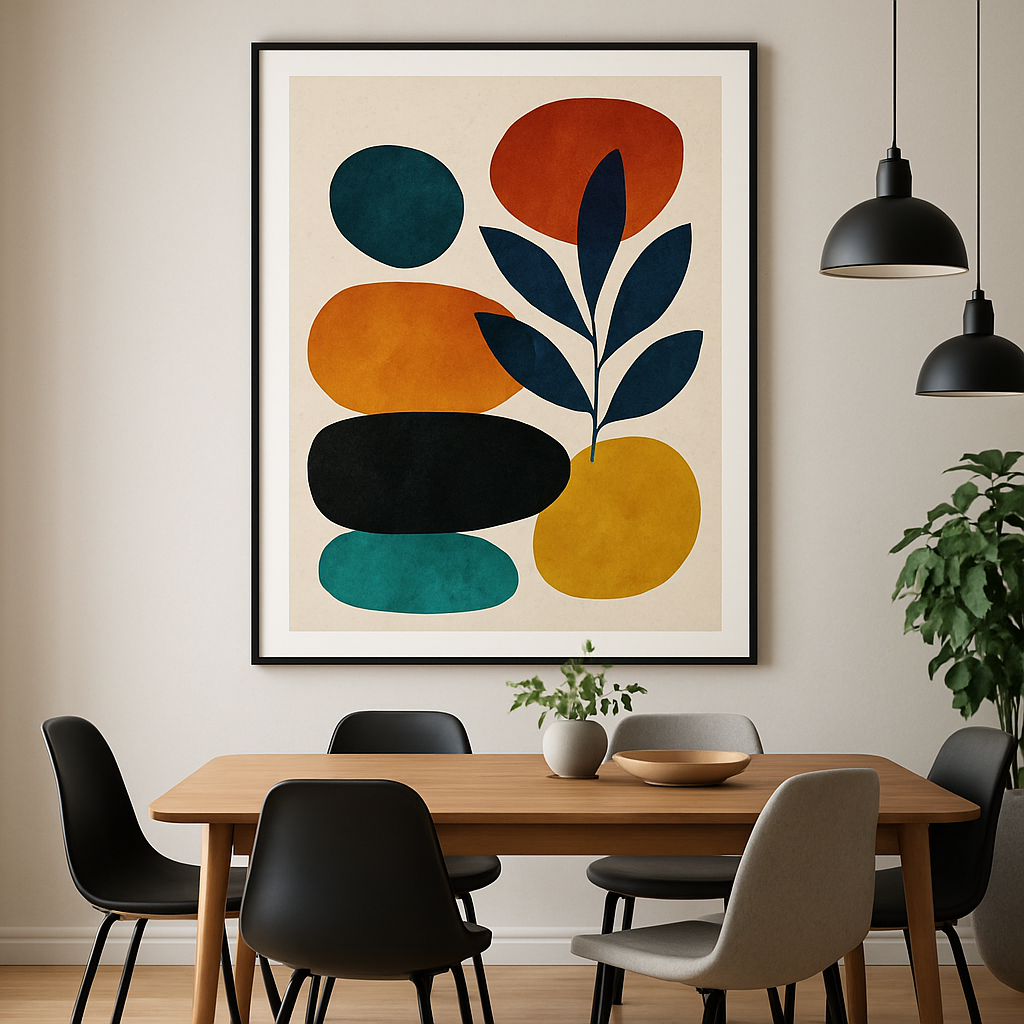
A stylish modern dining room showcasing a vibrant abstract artwork and a cozy table setup.
Dining rooms offer unique art placement considerations, as viewers are primarily seated rather than standing. In these spaces, hang art slightly lower than the standard eye-level height to account for seated viewing positions. The wall opposite the dining table provides an excellent canvas for a statement piece that diners can enjoy throughout their meal.
For kitchen areas, consider the practical challenges of the environment. Avoid placing valuable or paper-based prints near heat sources or areas prone to splashing. Instead, opt for glass-framed prints or canvas pieces that can withstand occasional moisture. Kitchens provide wonderful opportunities for food-themed art, vintage advertisements, or colorful abstracts that enhance the warmth of your culinary space.
Open-concept gathering spaces benefit from thoughtfully placed art that helps define different functional zones while maintaining visual cohesion. Consider a multi photo frame arrangement that creates a focal point while tying together the color scheme of your open space.
Fireplace mantel, entryway, hallways, and stairs
The space above a fireplace mantel presents a natural focal point for statement art. Position your piece so the bottom edge sits 4-6 inches above the mantel, creating breathing room while maintaining visual connection. Scale is crucial here—select art that’s proportional to both the mantel width and the overall fireplace structure.
Entryways offer the first impression of your home’s aesthetic, making them perfect for impactful, personality-filled prints. Consider how the art will be viewed as guests enter your space, and select pieces that establish the tone you want to convey. In narrow entryways, vertical pieces can enhance the sense of height.
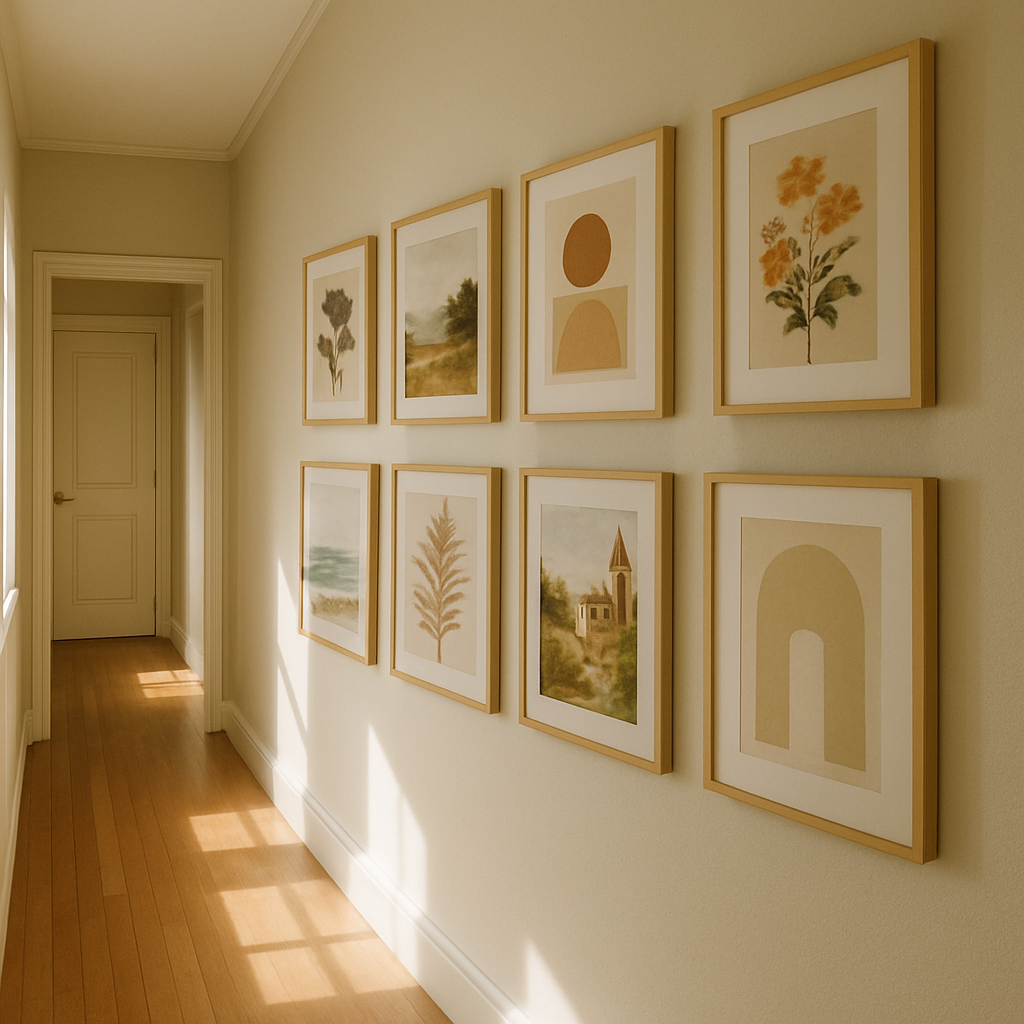
A cozy hallway decorated with a gallery wall of art, enhanced by warm lighting and natural textures.
Hallways and staircases present unique opportunities for creating gallery displays that tell a story as one moves through the space. For hallways, maintain consistent spacing and alignment between pieces, typically hanging at standard eye level.
When hanging art in children’s spaces, adjust your height calculations downward to accommodate their eye level. Consider mounting pieces slightly higher than their current eye level to allow for growth, or plan to adjust positioning periodically. Safety concerns are paramount—ensure all frames are securely mounted with appropriate hardware, and avoid glass in areas where very young children play unsupervised.
Children’s rooms offer opportunities for more playful, colorful art that stimulates imagination. Consider creating a gallery wall that can evolve with your child’s interests, using secure but easily changeable hanging systems that allow for updates as preferences change.
Home offices benefit from inspiring, focus-enhancing art that complements productivity. Position motivational prints or concentration-supporting abstract pieces within your line of sight while working, but avoid potentially distracting imagery directly behind computer screens.
Style, color, and composition tips
Creating cohesive wall art displays requires attention to style, color relationships, and overall composition. The difference between randomly hung pictures and a thoughtfully designed art display lies in these intentional choices that create visual harmony.
When building gallery wall ideas, begin by establishing a unifying element—consistent frame styles, color palette, subject matter, or artistic medium. This creates cohesion even when mixing different sizes and orientations. For a more eclectic approach, try maintaining consistent spacing between frames (typically 2-3 inches) while varying other elements.
Color coordination significantly impacts how wall art integrates with your space. Consider whether you want your art to complement your existing color scheme or provide striking contrast. Pull accent colors from your artwork into room accessories for a designed look that feels intentional rather than accidental.
Frame selection influences how artwork reads in your space—thin black frames create a modern, gallery-like appearance; ornate gold frames bring traditional elegance; while frameless canvas prints offer a contemporary, casual vibe. For a collected-over-time look, intentionally mix frame styles while maintaining some unifying element like color or material.
When creating multi-piece displays, layout matters tremendously. Start by arranging pieces on the floor before committing to wall placement. For formal spaces, symmetrical arrangements provide balance and elegance. More casual areas benefit from asymmetrical groupings that maintain visual weight distribution without perfect symmetry. Looking for a statement piece to anchor your display? Bauhaus wall art with bold geometric patterns makes a stunning focal point.
Practical hanging and safety guidelines
Successfully executing your wall art vision requires proper tools and techniques. Beyond aesthetic considerations, safety factors should guide your installation process, especially in homes with children, in earthquake-prone areas, or where hanging particularly heavy pieces.
Before making any holes, gather appropriate tools: a tape measure, level, pencil, appropriate hardware for your wall type, and preferably a helper for larger pieces. Different wall materials require specific hanging methods—drywall benefits from wall anchors or stud mounting; brick or concrete walls need specialized masonry hardware; while plaster walls often require special care to prevent cracking.
For gallery walls, create paper templates of each frame and tape these to your wall first. This allows you to adjust positioning before committing to hardware placement. When hanging multiple pieces, start from the center and work outward, checking level and alignment frequently.
Safety considerations should never be overlooked. For pieces hanging above beds or seating areas, use secure mounting hardware rated for more than your item’s weight. In homes with young children, consider mounting hardware that locks frames to the wall, preventing them from being pulled down accidentally. Earthquake-prone areas benefit from specialized hardware that allows frames to move slightly during seismic activity without falling.
For renters or those hesitant to create wall damage, numerous non-permanent solutions exist. Adhesive hanging strips work well for lightweight frames, while picture rails or leaning displays offer damage-free alternatives for heavier pieces. Command hooks rated for appropriate weights provide another removable option that won’t sacrifice style.
Tools & tips checklist
- Tape measure and level
- Pencil for marking (easily erased)
- Wall-appropriate hardware (anchors, screws, hooks)
- Hammer or drill with appropriate bits
- Wall detection tool to locate studs/pipes/wires
- Picture hanging wire for larger frames
- Cleaning supplies for fingerprints post-installation
For heavier items (over 10 pounds), always anchor to wall studs or use appropriate heavy-duty wall anchors. When in doubt about structural support or for especially valuable artwork, consulting a professional installer may be worth the investment for both safety and aesthetic results.
Wall art placement transforms houses into personalized homes, expressing your unique style while creating visual interest throughout your space. There’s truly no single “correct” way to display art—the best approach honors both design principles and your personal connection to the pieces you choose. Don’t be afraid to experiment with placement, groupings, and even seasonal rotations that keep your space feeling fresh and inspired.
The most successful wall art displays develop over time, evolving as you acquire new pieces and refine your aesthetic preferences. Start with these foundational guidelines, then trust your eye and emotional response to create a home filled with art that brings you joy every day. Consider visiting this blog for more retro wall art ideas or shop contemporary prints to bring new life to your walls.
Frequently asked questions
What is the ideal height to hang wall art?
Center art 57–60 inches from the floor, or adjust to eye level by scenario; over furniture, leave 4–8 inches of clearance.
How do I choose the right size artwork for my wall?
Aim for art (or groupings) that span about 2/3 the width of furniture or wall space you’re filling for balance.
Can you hang art in bathrooms or kitchens?
Yes, but choose moisture-resistant or inexpensive art; avoid direct sunlight, steam, or areas prone to splashes.
Are gallery walls still in style?
Absolutely—gallery walls are versatile, on-trend, and allow personal collections; use consistent spacing for cohesion.
How can I hang pictures without damaging my walls?
Use adhesive strips, hooks, or rails, especially for renters; always double-check for pipes/cables before drilling.